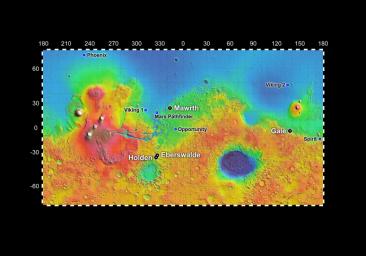
|
Four Finalist Landing Site Candidates for Mars Science Laboratory
- Click the image above for a larger view
- Full-Res JPEG (3000 x 2100) (878.8 kB)
- Full-Res TIFF (3000 x 2100) (18.9 MB)
Caption:
Out of more than 30 sites considered as possible landing targets for NASA's Mars Science Laboratory mission, by November 2008 four of the most intriguing places on Mars rose to the final round of the site-selection process.
The four finalists are, alphabetically: Eberswalde, where an ancient river deposited a delta in a possible lake; Gale, with a mountain of stacked layers including clays and sulfates; Holden, a crater containing alluvial fans, flood deposits, possible lake beds and clay-rich deposits; and Mawrth, which shows exposed layers containing at least two types of clay.
The locations of these four candidates are indicated here on a background map of color-coded topographical data from the Mars Orbiter Laser Altimeter on NASA's Mars Global Surveyor. Red is higher elevation; blue is lower elevation. In latitude, the map extends from 70 degrees (north) to minus 70 degrees (south). The east-west axis is labeled at the top in degrees of east longitude, with the zero meridian at the center.
The Mars Science Laboratory mission's capabilities for landing more precisely and at higher elevation than ever before, for driving farther, and for generating electricity without reliance on sunshine have enabled consideration of a wider range of possible landing sites than for any previous Mars mission. During the past two years, multiple observations of dozens of candidate sites by NASA's Mars Reconnaissance Orbiter have augmented data from earlier orbiters for evaluating sites' scientific attractions and engineering risks.
More than 100 Mars scientists have participated in a series of open workshops presenting and assessing data that the orbiters have provided about the candidate sites. The four sites rated highest by researchers at a September 2008 workshop were the same ones chosen by mission leaders after a subsequent round of safety evaluations and analysis of terrain for rover driving.
As a clay-bearing site where a river once flowed into a lake, Eberswalde Crater offers a chance to use knowledge that oil industry geologists have accumulated about locations of the most promising parts of a delta to look for any concentrations of carbon chemistry that is crucial to life.
The mountain inside Gale Crater could provide a route for the rover to drive up a 5-kilometer (3-mile) sequence of layers, studying a transition from environments that produced clay deposits near the bottom to later environments that produced sulfate deposits partway up.
Running water once carved gullies and deposited sediments as alluvial fans and catastrophic flood deposits in Holden Crater, a site that may also present the chance to evaluate layers deposited in a lake. Exploration of key features within this target area would require drives to the edge of a broad valley, and then down into the valley.
Mawrth Valley is an apparent flood channel near the edge of vast Martian highlands. It holds different types of clays in clearly layered context, offering an opportunity for studying the changes in wet conditions that produced or altered the clays. The clay signatures are stronger than at the other sites, and this is the only one of the four for which the science target is within the landing area, not nearby.
Background Info:
NASA's Jet Propulsion Laboratory, operated by the California Institute of Technology in Pasadena, manages the Mars Science Laboratory for the NASA Science Mission Directorate, Washington.
Cataloging Keywords:
| Name | Value | Additional Values |
|---|---|---|
| Target | Mars | |
| System | ||
| Target Type | Planet | |
| Mission | Mars Science Laboratory (MSL) | Mars Global Surveyor (MGS), Mars Reconnaissance Orbiter (MRO) |
| Instrument Host | Curiosity Rover | Mars Global Surveyor, Mars Reconnaissance Orbiter |
| Host Type | Rover | Orbiter |
| Instrument | ||
| Detector | ||
| Extra Keywords | Color, Crater, Dust, Map, Mountain, Water | |
| Acquisition Date | ||
| Release Date | 2008-11-19 | |
| Date in Caption | ||
| Image Credit | NASA/JPL-Caltech | |
| Source | photojournal.jpl.nasa.gov/catalog/PIA11432 | |
| Identifier | PIA11432 | |
